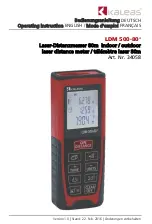
Model 2651A High Power System SourceMeter® Instrument Reference Manual
Section 7: Command reference
2651A-901-01 Rev. A / March 2011
7-365
Also see
tspnet.read()
This function reads data from a remote device.
Type
TSP-Link accessible
Affected by
Where saved
Default value
Function Yes
Usage
value1
= tspnet.read(
connectionID
)
value1
= tspnet.read(
connectionID, formatString
)
value1, value2
= tspnet.read(
connectionID, formatString
)
value1, ..., valuen
= tspnet.read(
connectionID, formatString
)
value1
The first value decoded from the response message
value2
The second value decoded from the response message
valuen
The nth value decoded from the response message; there is one return value per
format specifier in the format string
...
One or more values separated with commas
connectionID
The connection ID returned from
tspnet.connect()
formatString
Format string for the output, maximum of 10 specifiers
Details
This command reads available data from the remote instrument and returns responses for the specified number
of arguments.
The format string can contain the following identifiers:
%[width]s
Read data until the specific length
%[max width]t
Read data until the specific length or delimited by punctuation
%[max width]n
Read data until a newline or carriage return
%d
Read a number (delimited by punctuation)
A maximum of 10 format specifiers can be used for a maximum of 10 return values. If
formatString
is not
provided, the command returns a string containing the data until a new line is reached. If no data is available, the
Model 2651A pauses operation until the requested data is available or until a timeout error is generated. Use
tspnet.timeout
to specify the timeout period.
When reading from a TSP-enabled remote instrument, the Model 2651A removes Test Script Processor (TSP
®
)
prompts and places any errors received from the remote instrument into its own error queue. The Model 2651A
prefaces errors from the remote device with "Remote Error," and follows this with the error number and error
description.
Example
tspnet.write(myID, "*idn?\r\n")
print("write/read returns:", tspnet.read(myID))
Send the
"*idn?\r\n"
message to the
instrument connected as
myID
.
Display the response that is read from
myID
(based on the
*idn?
message).
















































